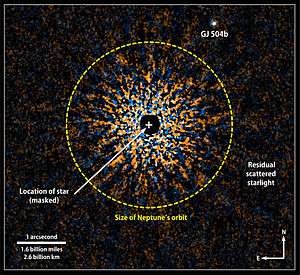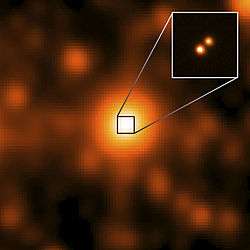Gliese 504 b
Gliese 504 b (often shortened to GJ 504 b) is a Jovian planet or a brown dwarf[3] in the system of the solar analog 59 Virginis (GJ 504),[note 1] discovered by direct imaging using HiCIAO instrument and AO188 adaptive optics system on the 8.2-meter Subaru Telescope of Mauna Kea Observatory, Hawaii by Kuzuhara et al.[4] Visually, GJ 504 b would have a magenta color.[5]
 NASA artist's impression of Gliese 504 b. | |
| Discovery | |
|---|---|
| Discovered by | NASA's Kepler space telescope |
| Discovery site | Subaru Telescope |
| Discovery date | 2013 |
| Direct imaging | |
| Orbital characteristics | |
| 31–129 AU | |
| Eccentricity | 0.01–0.62[1] |
| 155–1332[1] y | |
| Inclination | 111–171[1] |
| 8–173[1] | |
| 2005.07–2825.03[1] | |
| 4–176[1] | |
| Star | 59 Virginis (GJ 504) |
| Physical characteristics | |
Mean radius | 0.96±0.07[2] RJ |
| Mass | (various estimates, see text) MJ |
| Temperature | 544±10 K (271±10 °C)[2] |
History of observation
The discovery images were taken in 2011 and common proper motion was confirmed in 2012 as part of the Strategic Explorations of Exoplanets and Disks with Subaru (SEEDS) survey. The SEEDS survey aims to detect and characterize giant planets and circumstellar disks using the 8.2-meter Subaru Telescope. In February 2013 Kuzuhara et al. submitted the discovery paper to The Astrophysical Journal, and in September it was published.[4] A follow-up study published in the October 2013 edition of the Astrophysical Journal confirmed methane absorption in the infrared H band, the first time this has been done for a directly imaged planet that formed within a disk.[6]

Properties
GJ 504 b's spectral type was originally projected to be late T or early Y, and a follow-up study estimated that a T8 spectral type was the best fit.[6] Its effective temperature is 544±10 К (271±10 °C),[2] much cooler than previously imaged exoplanets with a clear planetary origin. The angular separation of the planet from its parent star is about 2.5 arcseconds, corresponding to a projected separation of 43.5 AU,[4] which is nearly nine times the distance between Jupiter and the Sun, which poses a challenge to theoretical ideas of how giant planets form.[5] This planet is seen as an excellent target for detailed spectroscopic characterization due to its proximity to Earth and its wide separation.
Estimated mass of Gliese 504 b depends on the value of its age, which is poorly known. The discoverers adopted age value 0.16+0.35
−0.06 Gyr and estimated mass as 4.0+4.5
−1.0 MJup.[4] In 2015, other astronomers obtained age value 4.5+2.0
−1.5 Gyr, which corresponds to 20-30 MJup. In this case, the object is a brown dwarf rather than a planet.[7] In 2017, an intermediate age value 2.5+1.0
−0.7 Gyr was published.[3] Even with the lowest age, it is the oldest extrasolar planet directly imaged, as for 2013.[4]
Notes
- In spite of names of some exoplanets, derived from theirs host stars Flamsteed designations (for example, 51 Pegasi b, 61 Virginis b, 70 Virginis b etc.), the discoverers of this exoplanet did not use a similar name (i.e. "59 Virginis b") to refer to it, but used the designation "GJ 504 b" instead, derived from the Gliese–Jahreiß identifier of its parent star "GJ 504".
References
- Blunt, Sarah; et al. (2017). "Orbits for the Impatient: A Bayesian Rejection-sampling Method for Quickly Fitting the Orbits of Long-period Exoplanets". The Astronomical Journal. 153 (5). 229. arXiv:1703.10653. Bibcode:2017AJ....153..229B. doi:10.3847/1538-3881/aa6930.
- Skemer, A. J.; Morley, C. V.; Zimmerman, N. T.; et al. (2016). "The LEECH Exoplanet Imaging Survey: Characterization of the Coldest Directly Imaged Exoplanet, GJ 504 b, and Evidence for Superstellar Metallicity". The Astrophysical Journal. 817 (2): 166. arXiv:1511.09183. Bibcode:2016ApJ...817..166S. doi:10.3847/0004-637X/817/2/166.
- D'Orazi, V.; Desidera, S.; Gratton, R. G.; et al. (2017). "A critical reassessment of the fundamental properties of GJ 504: chemical composition and age". Astronomy & Astrophysics. 598: A19. arXiv:1609.02530. Bibcode:2017A&A...598A..19D. doi:10.1051/0004-6361/201629283.
- Kuzuhara, M.; Tamura, M.; Kudo, T.; Janson, M.; Kandori, R.; Brandt, T. D.; Thalmann, C.; Spiegel, D.; Biller, B.; et al. (2013). "Direct Imaging of a Cold Jovian Exoplanet in Orbit around the Sun-like Star GJ 504". The Astrophysical Journal. 774 (11): 11. arXiv:1307.2886. Bibcode:2013ApJ...774...11K. doi:10.1088/0004-637X/774/1/11.
- "Astronomers Image Lowest-mass Exoplanet Around a Sun-like Star". NASA. 2013-08-05. Archived from the original on 2017-06-29.
- Janson, M.; Brandt, T. D.; Kuzuhara, M.; et al. (2013). "Direct Imaging Detection of Methane in the Atmosphere of GJ 504 b". The Astrophysical Journal Letters. 778 (1): L4. arXiv:1310.4183. Bibcode:2013ApJ...778L...4J. doi:10.1088/2041-8205/778/1/L4.
- Fuhrmann, K.; Chini, R. (2015). "On the age of Gliese 504". The Astrophysical Journal. 806 (2): 163. Bibcode:2015ApJ...806..163F. doi:10.1088/0004-637X/806/2/163.


